Shocking your pool, or super chlorinating, is a cleaning method designed to keep your pool water clean and safe by adding three to five times the normal amount of chlorine. This drastically raises the chlorine level in a short period of time. Shocking your pool should not be a daily routine. Sure, there are times when shocking your pool is absolutely necessary like the times when you neglect your pool or when your pool is recovering from a terrible storm. However, if you have a salt water generator and consistently test and monitor your chemical levels, there shouldn’t be a need to shock your pool often.
Pool owners usually have a single concern when shocking their pool- How long after I shock my pool can I swim?
Unfortunately, there is no general consensus within the pool community when it comes to determining how long you should wait before swimming again. However, even with no general consensus, we were still able to discover many convincing factors that helped narrow down when the pool is safe for swimmers again after shocking. (If’ you’re a skim reader and just looking for the answer, read the last paragraph.)

How Dirty Is Your Pool?
Generally speaking, most balancing chemicals,(such as pH, alkalinity, and calcium hardness) become part of your pool water within an hour or so after adding them, at which time, you should be able to swim. Shocking, on the other hand, takes longer to adjust the pool. As a result, there has to be a longer waiting period before it is safe for swimming. But exactly how long must one wait before the water is safe for swimming? There are usually factors you need to consider before giving your swimmers a realistic time frame before jumping in.
First, assess how bad or dirty your pool actually is. Obviously, pools that are days away from becoming a swamp require more time and maintenance than a pool recovering from a rainy day. And swimming pools that require an extensive treatment due to algal blooms are in a class of their own. It can literally take weeks. On average, pool owners use three to five times the normal dosage when shocking. However, during serious conditions, some pools may need five to ten times the normal dosage.
The purpose for such a large dose is to break down the combined chlorine, organic waste, and other contaminants in your pool and re-establish a positive level of free chlorine. This process is not instant and can take several days to conquer. The condition and the chemical levels in every pool vary. That is why it is impossible for a pool technician to hand out specific time frames that are suitable for EVERY pool.
What Kind of Shock Are You Using?
The type of shock you use to shock your pool also affects how long you have to wait until you jump back into the pool. The two most popular shocks we encounter at INYO 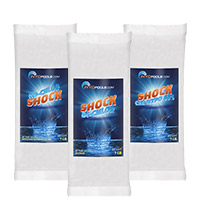 are shocks with chlorine and shocks without chlorine. Shocks with chlorine, or cal-hypo, make up the majority of chlorine- based shock available today. The major differences lie in the concentration levels of the active ingredients. Most shocks with chlorine take longer to interact with your pool than non-chlorine shock.
are shocks with chlorine and shocks without chlorine. Shocks with chlorine, or cal-hypo, make up the majority of chlorine- based shock available today. The major differences lie in the concentration levels of the active ingredients. Most shocks with chlorine take longer to interact with your pool than non-chlorine shock.
Chlorine- free shock oxidizes bacteria and organics in your pool without any additional chemicals. With this type of shock, you can swim in the pool just one hour after. Chlorine- based shock contains high levels of pH and will alter both your pH and chlorine levels in the pool. Chlorine- free shock has a neutral pH and will not affect any of your other chemical levels.
It’s a general precaution to monitor the type of chemicals you are putting into your pool. As you can see, even the type of shock you use can affect other chemicals that are already in your pool. And in turn, it will delay your swimmers from returning to the pool.

How Long Should I Wait… Exactly?
I’ve written a couple of paragraphs so far but haven’t actually answered the question at hand, how long after shocking your pool do you have to wait until you swim again? Technically, if your free chlorine levels are holding up, swimming UP TO your shock level, depending on your CYA, is safe. Keep in mind, no one should swim in a cloudy pool, even if your free chlorine levels are holding. If the water clarity prevents you from seeing the bottom of the pool, we recommend you do not return back to the pool. From a security standpoint, it prevents you from watching for submerged children.
Another good rule of thumb is to follow the manufacturer’s instructions on the back of the product. Typically on all chemicals, the manufacturer provides directions for use, precaution warnings, and tips for storage and disposal. The back the bag of shock we analyzed states, “Follow label directions for each product. Re-entry into treated pools is prohibited above 4 ppm.” The manufacturer’s caveat runs parallel with swimming up to your shock level.
In short, if you want to be certain that your water is safe before returning to swim, test it. Once your free chlorine levels are holding and you can see the bottom of your pool, you can safely return swimming up to your shock levels for your CYA. Secondly, review the instructions on the back of your shock. Most companies provide the levels they recommend swimmers are safe to return back to the pool.

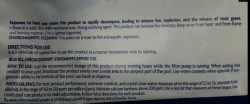
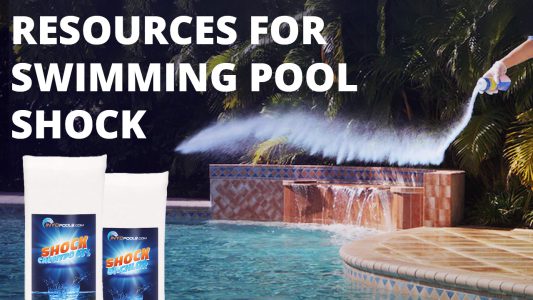

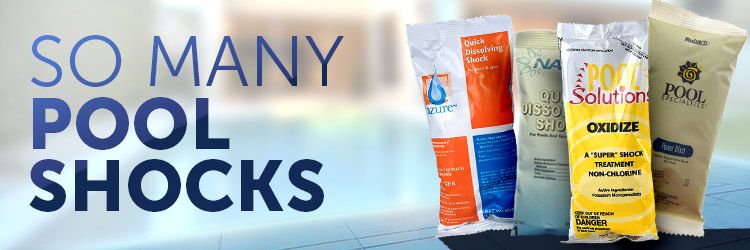
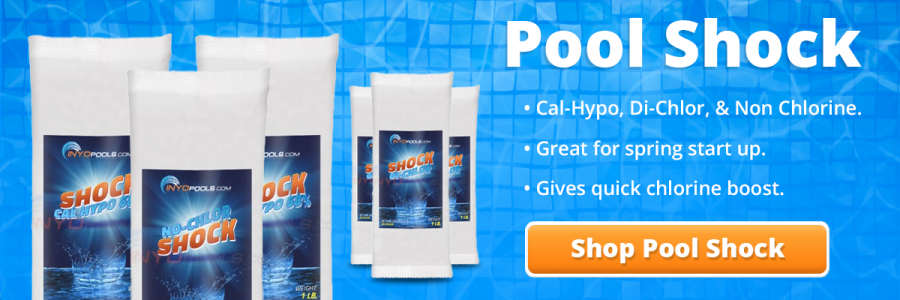






We filled our poor and the water is brown no one has been in it yet. So I went and got some shock treatment and the filter is on. So my question is, is it safe to swim in the brown water and it’s a 14ft x 42in pool. I’ve never had a pool before and clueless but my kids wanted a pool so here I am and completely lost but they are dying to swim and I don’t know if it’s okay.
Did you fill the pool with well water? If so, that brown is minerals and metals. Use a treatment of metal control to clear up the brown, and make sure the rest of your water chemistry levels are in the proper ranges before allowing the kiddies to swim. Untreated water can make swimmers sick.
hahaha…got me to read the whole thing, then never gave an answer to the title of your article! What a waste of time. Thank YOU all the responders for actually providing something useful!
So,if I shock say at 8:00 am and it’s apparent it was enough shock for the algae, do I add more shock up to the amount I should have done in the am or do I start from scratch ?
I just shocked my pool a few minutes. Do I need to wait before adding additional chemicals like calcium and alkalinity?
To be on the safe side, I would wait four hours between the application of each chemical.
Alkalinity and PH should be in range before shocking. In your case you should wait until chlorine levels are 3-5 PPM. Unless you have a heater which require a certain calcium hardness reading to keep your warranty you should wait until all other chemicals are in check. Add Calcium slowly. NEVER more than 10lbs at 1 time. I raised mine using half the amount recommended adding 5Lbs a day.
Thanks for the article. Really useful. So I’ve got into a situation I can’t find explained anywhere.
I shocked my pool due to heavy use. Before shocking both TC and FC were both about 1ppm. After shocking FC went up to 10ppm. So far, so good.
Firstly, I wasn’t sure whether I was supposed to put a “normal” (as in non shock related – the ones I always use) chlorine block in the shutter filter straight after shocking. It’s not mentioned in any blogs I could find or on the instructions. Figuring more chlorine is what I was after I did put it in as per my normal maintenance routine.
Now after 3 days, FC remains really high registering 10ppm so I don’t want to allow my kids in the pool. And more worryingly TC is higher than I’ve ever seen it – looks around 5ppm.
I’m confused as I expected the FC to come down more quickly. The pool has been covered and it hasn’t been very sunny which may explain it. But its a vinyl liner and I understand high chlorine isn’t good for that so I’m wondering firstly if the water is in a good status (it looks great – really clear)? and secondly if the TC and FC are anything to worry about – should I remove all chlorine from the system for, say 24 hrs, to let FC drop below 5ppm to start swimming again?
Remove the cover and after sunny day or two, the chlorine should drop to a safe enough level.
That simple – thanks very much Matthew.
Hello there i tried reading all the comments to see if I can find my answr before asking, however I did not. What happens if you get in like 15 min after the treatment started??!!! I had not know the pool people were here and when I got our the pool I saw they left a note on the door. I have a salt water pool.
Enjoying this exchange. How can I tell how much free chlorine I have and total chlorine? I just shocked our 10K gal. above ground pool with three bags of shock (1 lb. ea.). The pool store told me this kind of chlorine is pH neutral, unlike the liquid. It’s hot outside! I really want to go in. Crying emoji.
There are tons of test strip kits that measure free chlorine (FC) and total chlorine (TC). You can get those at a local pool store.
When can you swim after going through the salt generator process?
Do you mean after installing a brand new salt generator? We suggest doing a shock dose of the pool after you install the SWG and it is up and running. This will boost your chlorine levels while the cell builds a solid base of chlorine in the pool. So again, it would come back to testing the water to determine to determine when you can swim. I would hold off getting in the pool until the level is 5 ppm.
15×8 pool starting to turn a little green, can pool shock still save it if I change my filter too?
Yes, the water can still be saved. Read this article for some guidance: How to Clean a Green Pool?
I have unsafe chlorine levels and put in 5x the amount of shock I should have. CAN I JUMP IN?
Ooooph, this is a tough one. I’m going to have to say, no.
For real??? Hahaha
We put a bag of shock in our big pool Around 10:30 this morning is it OK if we start swimming in it Or how long do we have to wait for it to be OK
Test your water. Is your water still at “shock level” or has it returned to normal?
Sounds like somebody just wants to jump in! Go ahead!
Total click bait crap content. Thanks for wasting my time. Stop listening to your SEO company. This is a bad business practice and won’t get you customers. Actually people will probably leave you bad reviews after you waste their time.
Why do you say that? I found the article informative and the advice reasonable. You are nothing but an out of touch jerk in thinking it was click bait. Grow up, moron…
There is no clear cut answer . Every situation is different . Common sense is in order and test the pool. I found the information helpful.
But i put way too much shock in my pool. I know that i put three times the amount i was suppose to… how long to wait to make sure…. once the water is clear should i be safe to swim… this was about 48 hours ago.
In case you missed it in bold at the end:
There is this in the paragraph before that, as well:
I know
We had our 27′ above ground pool closed about 10 days ago. Weather is now crazy hot. Is it safe to swim with no pump running and winter chemicals in the pool?
What do you mean by “winter chemicals” and have you tested the water to find out what the levels are? If so, post them in a reply.
Thanks! I was looking through some of your older blogs, would I be better perhaps using a flocculating agent and vacuuming the pool until the filter is repaired?
Yes, Flocculant would be the quickest way to clear it up.
Hi Matthew – currently my pool water is cloudy, free chlorine levels and pH are fine although I haven’t measured Total chlorine yet however I was looking to shock the pool to try and clear the cloudiness. Additional problem is that our sand filter is currently broken so we are recirculating water but bypassing the filter.
Obviously we need to replace the filter ASAP, but would a shock still be effective without it?
Chances are, the cloudiness is either dead algae or some other particulates. The only way to remove these particles is by having an operational filter. The shock will keep your chlorine levels up, preventing more algae growth but it won’t clear the cloudiness.
low Ph levels can cause cloudiness
High pH is the more common cause.
Hi Matthew. I have a 6×3 metre pool here in Valencia, Spain. Readings this morning show that ph is pretty much perfect, but chlorine is down. I’ve added a cup of shock via the skimmer. Pool is pretty clean, I’ll hoover and backwash this evening. If I test this evening (around 6 hours), and chlorine level is back to desired level, is it then OK to swim. Thanks buddy.
If the chlorine is still at shock levels, no. If the chlorine level is within the normal range, yes.
Matthew thank you for making a pool thread entertaining
Appreciate it 🙂
I have a above ground blow up ring pool it is 3’by 14’ round pool. I have never own a pool I keep a floater with a chlorine table in it. It has free algae I don’t have no way of vacuum it put green algae seems to be on the bottom I put pool tech algae use in it water looks clearer but still greenish on bottom what should I do or do you think it’s safe to swim in
OMG ANSWER THE QUESTION!!!!!!
We do. In the article, the last paragraph in BOLD explains the answer. Or if you manage to skip past the article, I explain it in the comment section.
Just answer the question??
ahahahahaha
if you are just shocking because it had too much use during the last few days like mine on the 4th of July, the water is clean and just shocking it to make it look better I say 2 Hrs. minimum. hope this help
For the skim readers out there, the short answer is waiting for 24 hours after a heavy dose of shock. Or if you really want to swim before the 24-hours is up, test the water to make sure the chlorine is within safe levels.
Curious where you get your info. What science is your recommendation based on?
Years of being in the pool industry, as well the wealth of knowledge provided by the technicians in our office, as well as the underrated ability to read instructions on product labels.
In my comment, there was not really any science, just more common sense.
My tech shock my 10,000 saltwater pool just to raise my chlorine level and to take the load off of the generator, it’s been over 100 degrees a lot. After 24 hours my chlorine reading is off the charts? My test kit only goes up to 3 but it must be at 5 or 6? The water is clean and looks good but it looked fine before the shock treatment. Is it safe to swim in the pool?
Is that the total chlorine level or free chlorine level you are providing?
What level is your CYA?
What if my free chlorine is 4 but my total chlorine is low is it ok to swim in? And I just shocked the pool now because I found dog poop in it! Is shocking enough so we can go back in?
How low is the reading? I need all the information to give an answer.
For your poop situation, read this blog: Someone Pooped in My Pool. What Do I Do Now?
I’m not a pool man, just a pool owner struggling to get a handle on all this, but my understanding is that if your free chlorine is 4, it’s in the ideal range. Your total chlorine — which is the sum of the free chlorine and the combined, or used -up, chlorine — must therefore be at least 4 (since it includes the free chlorine), and ideally would be no higher than 4, since you only want free — or useable — chlorine and none, or as little as possible, of the combined — or unusable — chlorine.
Sure it was not a Baby Ruth have Carl Spackler check.
How do you find dog poop in your pool???? is it in the ground or???
If you can’t spot the dog poop in your pool, then your water is a lot dirtier than you think it is.
How can I test it
buy test strips that test 6 things in pool Not 4 or 5. Your not getting an accurate picture with the cheap test strips. Also, if your pool store says your water is fine, but your test strips say its off. Throw those test strips away, buy new 6 test strips, next day you test and take sample to pool store for free testing. Ask them to Always test for everything.
I agree that throwing out old/tainted test strips is a necessary thing to do sometimes; who knows how many chemicals have been wasted in vain to correct an issue, falsely flagged by faulty strips. but the number of chemicals a strip can test for does not mark its quality. I would note the manufacturer of the kit as a sign of quality over the quantity of things the strip can test. I always lean towards Taylor kits when it comes to home testing.
Just used test strips from Walmart (test 6 things) and to my surprise it read Total and Free Chlorine @10ppm and CYA (stabilizer) @300 (as high as it can go). This worried me. I took my pool water sample to Pinch a Penny Pool store for more accurate reading and their test report showed FC @7.5 and CYA @100. Since numbers looked so different, I did another test at Leslies Pool Supplies (they claim to have better reading since they use computer based testing machine). Their reading showed FC @21 and CYA @185. In the end I decided to drain 1/3 of my pool and fill it with fresh water to fix high FC and CYA problem. So my recommendation is to start with inexpensive test strips that you can pick up at nearest Walmart and if some readings look off, then do more accurate computer test at one of nearest pool supply stores (usually free).
Or you could buy some good test strips from the get-go to save gas money and the time it takes to go to pool stores for redundant tests.
OK.. the dog poop.. I can’t even!!
Thanks this was very helpful
I know this is like 2 years after the fact, but I have a horrible pool guy that’s shocked it (nothing else) for about 10 Monday’s in a row, and the pool is very blue but foggy. Is it safe to swim?
As I say in a lot of these comments test the water, if it is in the safe zone then it is likely safe. If the pool person used algaecide then the cloudiness is likely from that or it could be dead algae that need to be filtered out.
I have a 8000 gallon pool I put one in bag of shock in it Its a new pool so first chimicles wct. How long should wait
How do you test it? Test it how? And what am i looking for or doing to test it.
Pool Water Testing
How do u test the levels
Testing a pool for chlorine levels is a basic building block of water chemistry. Pool Water Testing
If you have a pool, you should have some kind of test strips or a local pool company that tests your water. How it is done, depends on the type of test you have, but you just have to read and follow the instructions on the package.
that did help – thanks!!
Is this you son? 😉
Thank you! Thanks exactly why I was just shoking mine! I tested my pool & it was showing low chlorine which never happens. Can that be because of all the people I had in my pool yesterday? It didn’t appear dirty. But I figured I should shock it after all the action it had & to get the chlorine levels back up.
well said.
Right..
I was thinking the same thing!!
There is no clear answer as every pool’s situation is different and also filtration type. The answer is there, just read the article.
No shit